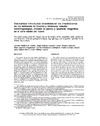Please use this identifier to cite or link to this item:
https://accedacris.ulpgc.es/handle/10553/73581
| Title: | Dos tumbas individuales calcolíticas en las inmediaciones de los dólmenes de Osorno y Simancas: estudio bioantropológico, ofrenda de perros y ‘postvida’ megalítica en el valle medio del Duero | Other Titles: | Two single graves from the Copper Age in the vicinity of the megalithic tombs of Osorno and Simancas: bioanthropological analysis, dog offerings, and megalithic 'afterlife' in the Middle Duero Basin | Authors: | Delibes de Castro, German Esparza Arroyo, Angel Velasco Vázquez, Javier Zapatero Magdaleno, Pilar Fernandez Rodriguez, Carlos Carbajo Arana, Maria Palomo Diez, Sara Misiego Tejeda, Jesus |
UNESCO Clasification: | 550501 Arqueología | Keywords: | Auricular Surface Ilium Mortuary Practices Pit-Graves Copper Age, et al |
Issue Date: | 2019 | Journal: | Trabajos de Prehistoria | Abstract: | The authors examine two unpublished pits with single burials from the Spanish Northern Meseta dating to the Pre-Bell Beaker Copper Age. Although such burials constitute the majority in the mortuary record of that time and place, we discuss the degree to which they are normative. We review the origins of the two-phased burial rituals, well attested in the area during the Bronze Age, the results of mitochondrial DNA and Y-chromosome analysis in one of the skeletons, and the importance of the often overlooked dog burials in the mortuary ceremonies of the Duero valley during the Copper Age. Lastly, the proximity of these two burials to the megalithic tombs of Los Zumacales (Valladolid) and La Velilla (Palencia) allow the authors to discuss the beginning of the 'afterlife` of these monuments in the middle Duero valley. Con motivo de presentar dos tumbas individuales en fosa inéditas, se aborda un estudio de conjunto sobre las prácticas funerarias del Calcolítico Precampaniforme en la submeseta norte española. Pese a su carácter mayoritario en el registro arqueológico, se discute la representatividad como norma de este tipo de sepulturas; se rastrean comportamientos propios de rituales de enterramiento en dos tiempos, preludio de los documentados en este mismo espacio en la Edad del Bronce; se aporta información sobre el ADN mitocondrial y sexo molecular de uno de los difuntos, y se pone el énfasis, por vez primera en el Calcolítico de la cuenca del Duero, en el protagonismo de los perros en el mundo funerario. Por último, la proximidad de las dos nuevas sepulturas a sendos dólmenes –Los Zumacales (Valladolid) y La Velilla (Palencia)‒ da pie a debatir sobre el inicio de la ‘postvida’ megalítica en el valle medio del Duero. |
URI: | https://accedacris.ulpgc.es/handle/10553/73581 | ISSN: | 0082-5638 | DOI: | 10.3989/tp.2019.12235 | Source: | Trabajos de Prehistoria [ISSN 0082-5638], v. 76 (2), p. 236-253, (Julio-Diciembre 2019) |
| Appears in Collections: | Artículos |
Items in accedaCRIS are protected by copyright, with all rights reserved, unless otherwise indicated.
